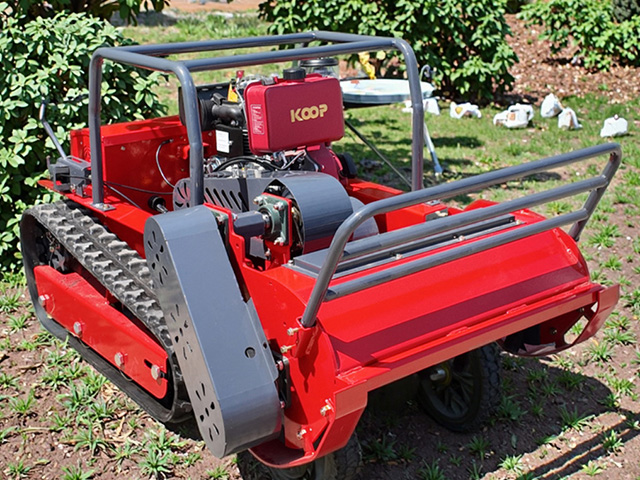Remote-Controlled Lawn Mowers Gain Popularity Across Europe and the United States
In recent years, the agricultural machinery industry has witnessed a significant transformation, with remote-controlled lawn mowers emerging as one of the most innovative and in-demand products. Particularly in Europe and the United States, the popularity of these machines has soared due to their safety advantages, precision cutting, and adaptability to complex terrain. Farmers, landscapers, and municipal maintenance teams are increasingly adopting remote-controlled mowers as essential tools for modern lawn and slope management.
Unlike traditional manual mowers that require close proximity operation, remote-controlled models allow users to manage the machine from a safe distance—often up to hundreds of meters away. This makes them particularly suitable for steep slopes, embankments, wetlands, and other hazardous areas where manual mowing is both inefficient and dangerous.

Technological Evolution Driving Growth
The growth of remote-controlled mowers is closely linked to technological progress in electric drive systems, wireless communication, and smart sensors. Modern models are equipped with advanced lithium batteries that deliver long working hours with zero emissions. Remote-control systems often include anti-interference features, real-time monitoring, and even obstacle avoidance powered by AI.
Some manufacturers have begun integrating GPS mapping and intelligent route planning, allowing operators to set mowing paths automatically. These “semi-autonomous” systems optimize mowing patterns, reduce overlap, and maximize battery efficiency—ideal for large estates, golf courses, and agricultural fields.
Q&A: Why Remote-Controlled Mowers Are in Demand
Q: Why are remote-controlled lawn mowers so popular in Europe and the U.S.?
A: Safety and efficiency are key reasons. These mowers can operate in steep or dangerous terrain where manual mowing poses risks. They also save time and labor, which makes them a favorite among commercial landscapers.
Q: Are remote-controlled mowers suitable for large areas?
A: Absolutely. Many models are designed to cover several acres efficiently, with powerful engines or electric motors that ensure consistent performance even on uneven ground.
Q: How do they compare in cost to traditional mowers?
A: While the initial investment is higher, remote-controlled mowers reduce long-term costs through lower labor requirements, reduced fuel use, and fewer safety-related expenses.
Europe: A Leader in Smart Mowing Solutions
In Europe, particularly in Germany, France, and the Nordic countries, remote-controlled mowing technology has become an integral part of landscape management. Municipalities use these machines for highway embankments, riverbanks, and renewable energy sites like solar farms, where grass control is vital for efficiency and safety.
Environmental consciousness also plays a major role. European buyers prioritize electric-powered mowers due to strict emissions standards and green initiatives. Manufacturers have responded by developing lightweight, high-efficiency electric versions that operate quietly and with minimal environmental impact.
The U.S. Market: Emphasis on Performance and Productivity
In the United States, the market for remote-controlled lawn mowers has grown rapidly among both residential and commercial users. Contractors and city maintenance departments are increasingly turning to these machines to maintain parks, slopes, and drainage channels safely.
American manufacturers emphasize power, ruggedness, and adaptability. Gasoline and hybrid models remain popular due to their extended runtime, while electric versions are gaining traction thanks to improved battery technology and state incentives for eco-friendly equipment.
Smart Features and Innovation in Design
Today’s remote-controlled mowers come with an impressive array of features that enhance usability and efficiency. Many include camera-assisted navigation, allowing operators to view live video feeds through mobile apps. Others feature automatic blade height adjustment, slope sensors, and anti-rollover systems to ensure stability even on 45° inclines.
The integration of smart connectivity is also reshaping how users interact with these machines. Through IoT (Internet of Things) technology, operators can track mowing progress, check system status, and receive maintenance alerts remotely. This level of precision and control makes modern mowers not just tools, but intelligent field companions.
Environmental and Economic Benefits
Remote-controlled mowers contribute to sustainability goals by reducing emissions, noise pollution, and fuel dependency. Electric and hybrid models, in particular, align with the EU’s Green Deal and the U.S. Environmental Protection Agency’s (EPA) clean energy initiatives.
From an economic perspective, these machines significantly cut labor costs. A single operator can manage multiple mowers simultaneously, increasing productivity while maintaining consistent quality. Moreover, lower maintenance and fuel requirements make them cost-effective in the long run.
Q&A: The Future of Remote-Controlled Mowing
Q: What trends will shape the future of this market?
A: The integration of AI and full automation. Fully autonomous robotic mowers that require minimal human input are already in development, merging precision agriculture with smart energy management.
Q: Will remote-controlled mowers replace traditional ones?
A: Not entirely. Traditional mowers still serve small farms and residential yards effectively, but remote-controlled and robotic systems will dominate commercial and professional sectors.
Q: Are there any challenges to wider adoption?
A: The main barriers include high initial costs and the need for skilled operators. However, as prices fall and training becomes more accessible, adoption rates will continue to rise.
Leading Brands and Market Outlook
Major global brands, including companies from China, Germany, and the U.S., are investing heavily in R&D for smarter, safer, and more energy-efficient designs. The European remote-controlled mower market is expected to grow at over 12% CAGR between 2025 and 2030, driven by automation and sustainability trends.
Manufacturers offering customization—such as slope-adapted tracks, interchangeable blades, and hybrid engines—are gaining a competitive edge. Strategic partnerships between mower producers and agricultural technology firms are also fueling innovation.
Conclusion: A New Era for Safe and Sustainable Mowing
Remote-controlled lawn mowers represent more than a technological upgrade—they mark a shift toward smarter, safer, and greener land management. Their rapid adoption across Europe and the United States demonstrates how innovation can solve real-world problems while supporting sustainability goals.
As environmental standards tighten and automation becomes more accessible, the remote-controlled mowing industry is poised to become a cornerstone of smart agriculture and modern landscaping.
5. Get Your Personalized Solution Now
→ Call the selection hotline: +86 158 5359 8030 (also supports accessory customization inquiries).









